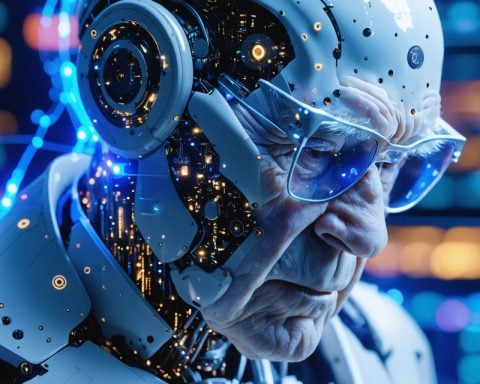- South Korea plans to acquire 10,000 GPUs for an AI computing center, aiming to compete globally in AI development.
- Elon Musk introduces Grok 3, an advanced AI model, along with the “Deep Search” project, to enhance AI performance in diverse fields.
- Baidu is set to integrate its Ernie language model with DeepSeek, enhancing its AI capabilities for a better user experience.
- The AI arena is marked by intense competition among nations and corporations, focusing on technology, regulation, and strategy.
- Success in AI will require balancing cutting-edge advancements with the complexities of global regulatory environments.
The world is teetering on the brink of an AI revolution, and the stakes have never been higher. South Korea has thrown its hat into the ring, seeking to acquire an impressive arsenal of 10,000 GPUs to solidify its place in the high-stakes AI game. This move is set to fuel the country’s upcoming AI computing center, signaling its intent to sprint ahead in the global AI race.
Against this backdrop of international maneuvering, tech titan Elon Musk steps into the spotlight, unveiling Grok 3—a formidable AI model that promises to eclipse even the most advanced offerings from industry heavyweights OpenAI and China’s DeepSeek. With the prowess of Grok 3, Musk aims to transform the landscape of AI capabilities, with leaps in performance in math, science, and coding challenges. Complementing this is Musk’s ambitious “Deep Search” project, heralded as a cutting-edge search engine designed to redefine online queries.
Meanwhile, Baidu, China’s search engine giant, is not to be overlooked. With plans to integrate its Ernie large language model with DeepSeek, Baidu is forging a path toward a richer, more diverse user experience. This initiative highlights a trend among tech behemoths to leverage AI advancements and strengthen their positions in a rapidly evolving digital world.
Yet, beneath the buzz and bullish innovations, lies a critical takeaway: the AI frontier is an arena where nations and corporations vie fiercely for supremacy. The winners will be those who not only wield cutting-edge technology but also navigate the complex interplay of global regulations and competitive strategies. As AI continues to shape our future, discerning investors and curious minds alike must keep their eyes peeled for the next breakthrough.
South Korea’s Bold GPU Move and Elon Musk’s Grok 3: Disrupting the AI Landscape
How-To Steps & Life Hacks
For those looking to emulate South Korea’s approach in their computing ventures, here’s a simplified route:
1. Identify Your Needs: Quantify and qualify the computing power you require. South Korea’s push for 10,000 GPUs is targeted at developing an AI supercomputing center.
2. Select the Right Hardware: High-performance GPUs like the NVIDIA A100, known for their prowess in AI workloads, should be prioritized.
3. Strategic Partnerships: Collaborate with global tech companies to ensure cutting-edge technology integration.
4. Regulatory Compliance: Stay ahead of international policies that govern technology use and data privacy.
Real-World Use Cases
AI and GPUs are not just theoretical constructs; they have practical applications across various domains:
– Healthcare: Accelerate drug discovery and personalized medicine.
– Autonomous Vehicles: Enhance decision-making algorithms and sensor processing.
– Finance: Optimize trading algorithms and fraud detection systems.
Market Forecasts & Industry Trends
– AI Spending: According to IDC, global AI spending is expected to double by 2024, reaching $110 billion. IDC
– Shift to Edge AI: Growing investment in edge computing solutions to perform real-time data processing.
Reviews & Comparisons
– Grok 3 vs. OpenAI’s Advanced Models: Grok 3 is reported to offer superior performance in specific areas like math and coding challenges. However, industry experts remain cautious about Musk’s broader claims without independent evaluations.
– Baidu’s Ernie vs. Competitors: While Ernie excels in language-specific processing advantages, it is yet to be seen if it can match the general adaptability of models like GPT from OpenAI.
Controversies & Limitations
– Ethical AI Use: Implementing AI has sparked debates over job displacement, privacy concerns, and potential biases.
– Performance Hype: While Grok 3’s capabilities are promising, skepticism persists until transparent testing and results are shared.
Features, Specs & Pricing
– Grok 3 Specifications: Musk has yet to divulge detailed specs, but similar models often boast billions of parameters requiring extensive computational power.
– Pricing: The cost of deploying AI models similar to Grok 3 could vary significantly, often scaling into millions of dollars, depending on infrastructure needs.
Security & Sustainability
– Security Risks: AI advancements are accompanied by heightened security risks, including data breaches and malicious AI activities.
– Sustainability Concerns: The high energy consumption of AI models demands solutions focused on efficiency and sustainable infrastructure initiatives.
Insights & Predictions
– Future Dominance: Experts speculate on the geopolitical tug-of-war AI could induce, heavily influencing technological and economic global standings.
– AI for Society: As AI becomes intertwined with daily life, its potential to revolutionize sectors like healthcare, education, and agriculture is underscored.
Tutorials & Compatibility
– Integration Tools: Platforms like TensorFlow and PyTorch facilitate the integration and development of AI-driven applications, supporting business and research needs. TensorFlow
Pros & Cons Overview
Pros:
– Enhanced Capabilities: AI models like Grok 3 promise unprecedented computational prowess.
– Innovation Boost: Drive technological advancements across industries.
Cons:
– Resource Intensive: High upfront costs and energy demands.
– Complex Integration: Requires considerable expertise and infrastructure setup.
Quick Tips
1. Stay Informed: Keep up-to-date with AI advancements and regulatory changes.
2. Invest in Education: Equip your workforce with the skills needed for an AI-driven future.
3. Embrace Collaboration: Engage with international partners to pool resources and expertise.
As global AI developments continue to unfold, it is imperative for nations and corporations to not only leverage technology but also prioritize ethical considerations and sustainability practices.



















